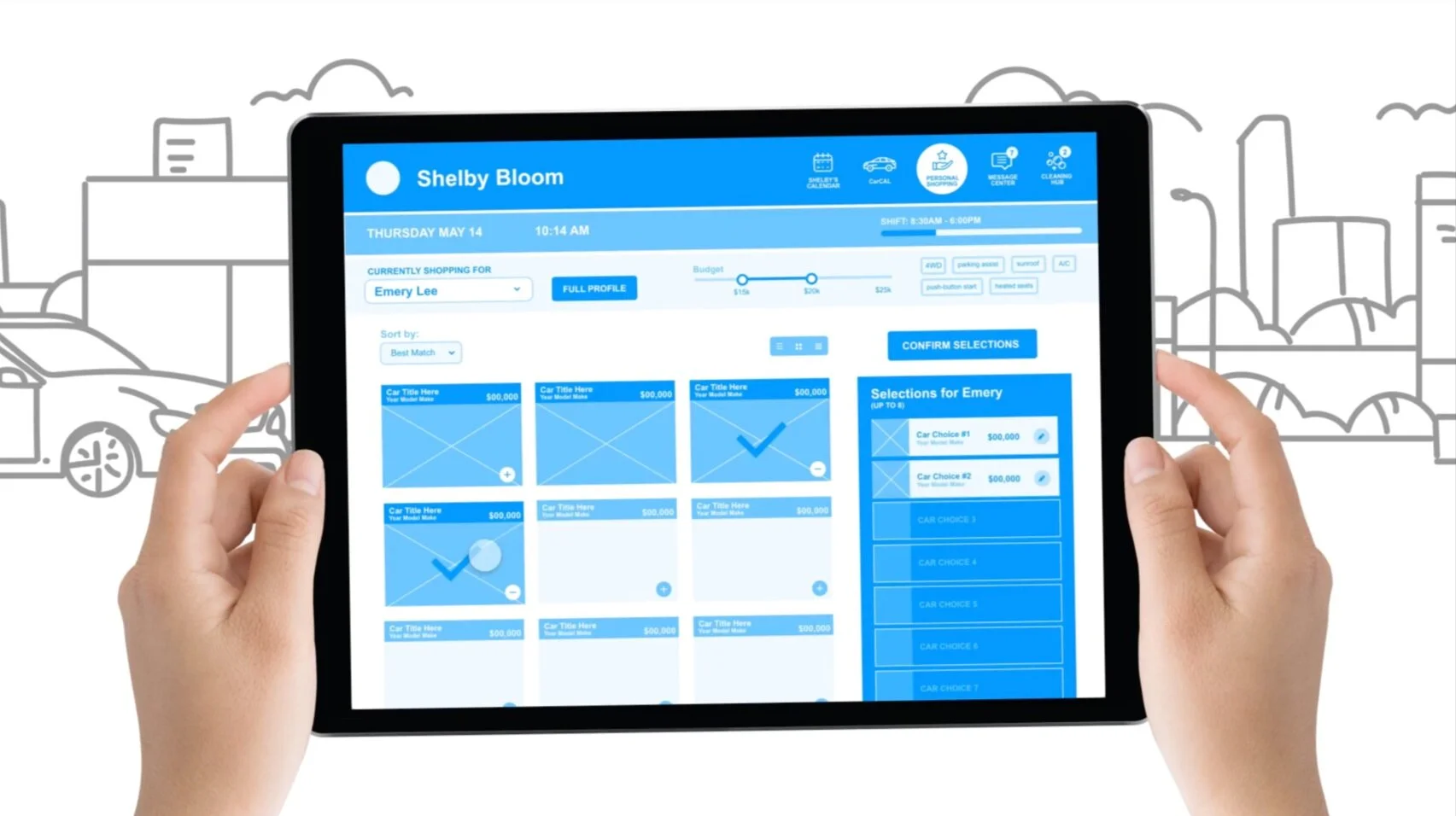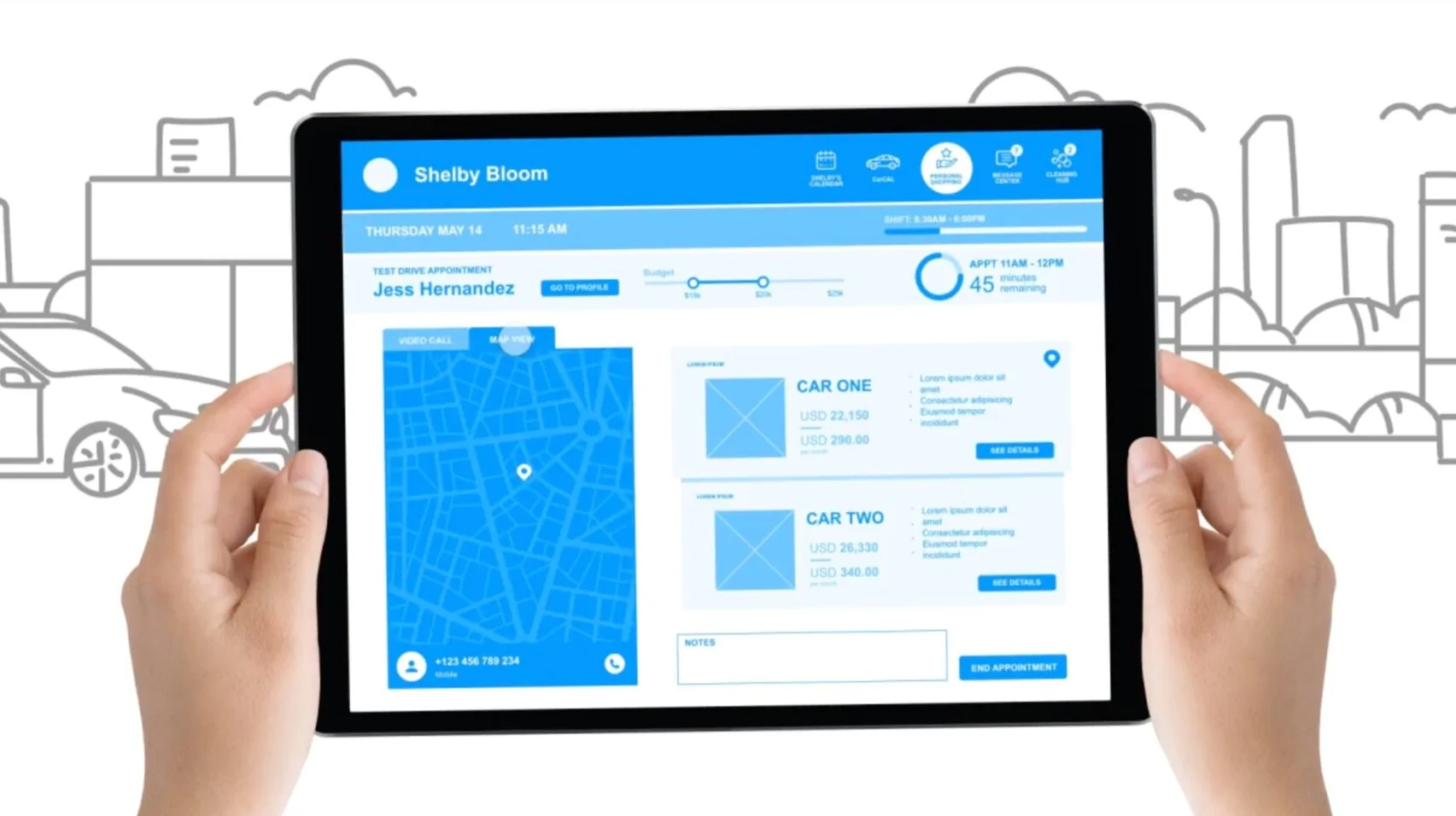NEXTDRIVE CAR SHOPPING SERVICE DESIGN
Our team was tasked with creating a holistic solution for car shopping during Covid-19 in light of compromised traditional shopping methods. Our proposed system provides increased safety considerations for both dealerships and customers while still providing an efficient and personalized experience.
CLIENT Student Case Study / ROLE UX Designer / Spring 2020 / DURATION 10 weeks
UX TEAM A. Edugyan, K. Levesque, T. Mark, L. Erilane, M. Chaddha
Defining the Problem
Challenge: In light of COVID-19 many things have changed in how we can safely participate in the world. Brick and mortar and physical retail locations have had to reconsider their marketing strategies and their customer experience. One business that is quickly trying to adapt is the automotive industry. Your challenge is to consider a holistic solution for a car dealership and how we may support them in this time.
To begin, the team came at this sideways and took part in a broad “How Might We” exercise to start simultaneously brainstorming as well as start defining our problem. The team contributed to a collaborative virtual board with potential HMWs given our problem space and current knowledge. We grouped by similarities and began to look for common threads. Many of our ideas touched on the need for transparency on both the dealership and customer side, as well as safety and trust. From here we worked to create a problem statement that encompassed all that we’d come up with. We mapped our ideas on a prioritization map, taking a look at importance vs feasibility, and flagging what felt most important to initially move toward.
Problem Statement: Consumers and dealerships need increased clarity, support and resources during COVID-19 because traditional auto shopping experiences are compromised.
User Research
To kick off our research process, the team took a look at our key assumptions and findings from our problem statement brainstorm. We identified a handful of key themes to further dig into. Prep research was conducted and tracked within a shared research log where we noted source, date, as well as key findings and questions for each. At this stage the team also drafted interview questions for both the dealership and customer side of things for future in-depth interviews.
As we moved forward, the team utlized a variety of research methods:
Desk Research We continually conducted desk research, maintaining a research log of source, date, and key findings/questions for each.
In-depth Interviews Our team developed questions and conducted in-depth interviews with a dealership owner as well as car buyers who had made a car purchase during COVID.
Recent Car Buyer Survey We created a survey for those who had purchased a car within the last year to gain more insights on shopping habits and expectations both before and after COVID restrictions began.
Online Ethnography Explored existing online chat offerings as well as other support currently available for customers, acting as an interested car shopper when inquiring.
Dealership Visits Conducted a dealership visit to explore the cross-channel experience from online search through dealer websites, to how the test drive and safety measures were actually conducted onsite.
Competitive Analysis Took a look at remote communication tools used for financial assistance and shopping research. Conducted comparison to understand what is currently being used, what works well, and what is missing.
Data Visualization
Taking our large body of research from the various methods, the team worked to synthesize the data and visualize the data. This allowed us to easily work with and communicate our key findings to others as we moved forward. Our learnings are reflected in the below stakeholder map, personas, and current state journey map showing the overlapping experience of both a customer and dealership employee.
Ideation
To start tackling the problems we’d identified, the group participated in multiple ideation exercises. Throughout the process the we used dot voting to narrow ideas and remain aligned on where we were headed.
HMW on Key Insights Using our six narrowed user stories, the team ideated on each for two minutes before coming together to sort and find key opportunity areas.
Crazy 8’s Based on a broad prompt of our problem statement, the team completed a Crazy 8’s exercise. Key opportunity areas found through dot voting centered around safety and time efficiency, which tracked with many of our initial assumptions.
Solution Sketching Based on our Crazy 8’s top voted ideas, the team divided up topics and did some broader solution sketching.
Idea Portfolio Using ideas from the previous exercises, we mapped each one based on impact and feasibility before deciding on the best solves.
Proposed Solution
The team took a look at our idea portfolio, and grouped together ideas that felt like natural pairs to start creating more rounded out solutions. From here we fleshed out three holistic ideas to pitch. Each idea considered both the full dealership staff as well as customers and layers of necessary backend support. All ideas were curated through the lens of prioritizing safety, efficiency and customized experiences. After review of each, the Personal Car Shopper concept was top voted by the team, which is what we moved forward with. This one felt like it had the most legs, and would support multiple users at once with potential to simultaneously address many problem spaces we’d identified. Below is the initial flow we outlined, then built out the experience from here.
Initial Prototyping
With our chosen concept, the team began some initial prototyping while making sure to explore a variety of methods. At this stage, many of our exercises were exploratory. They served to help us understand where we were missing information, and where we needed additional thought around the linking of ideas and stages. One of our earliest exercises was creating a service blueprint and future state customer journey map to help ground us in the larger picture and what the experience we were trying to create would look like before getting too granular.
From here we dove into prototyping: storyboarding, rehearsing digital services, sketching, paper and cardboard modeling, as well as some mockup visuals. This helped us look at various touchpoints, and really dive deep into what support was needed. Here is where we realized just how many backend systems would need to interlink to make this possible, including a booking system for the cars themselves as well as one to block off time on employee calendars. The cleaning process could also leverage these booking systems, so that no cars were missed in the process. Additionally, the car curating system used by employees would ideally pull from the existing inventory management system currently used by the dealership.
Validation & Mid-Fidelity Prototyping
Using our initial explores, we worked on refining our prototypes and creating higher fidelity deliverables with our learnings. Taking feedback from our focus groups we also added a test drive vehicle tracking tab for safety reasons, as well as implemented a flexible employee hub as the main app screen which would allow employees to swap out modules based on their individually most used features. We also dove into the cleaning process, and added a physical evidencing protocol. We worked out a system in which the only person entering vehicles that had been driven was the fully masked up cleaning staff. Personal shoppers would help signify which cars were ready by placing small marker cones on the backs of cars that had finished their appointments.
To help people understand the concept and gather early feedback, we also created a trio of quick videos walking through key features of the solution. Rendering these in a blueline stage with simple line drawings to indicate location allowed the visuals to have an in-progress feel and made it easier for people to feel comfortable giving feedback. Dealership employees as well as potential customers were walked through the solutions before being surveyed on how helpful they found the solution, how likely they were to use it, and any additional features they’d want to see implemented.
WORKING WITH THE PERSONAL SHOPPER
BOOKING A DISTANCED TEST DRIVE
TEST DRIVE RIDE ALONG SUPPORT
Final Pitch Materials
From here the team worked to bring our deliverables up to a high fidelity. In considering the importance of seamlessly guiding customers through the parking lot with clear signage, we created a brief brand style guide with a palette of eye-catching brights to support this purpose. Screens from each leg of the app offering were fleshed out for a clearer look at the offered functionality. Mockup imagery was created to showcase the kiosk vision and key retrieval. Parking lot flow and layout were mapped out, considering 6 feet of space between test drive stations as well as a designated spot to leave your car while test driving new ones. Lastly, we created a brief pitch video that could stand on its own walking through the entire flow of the journey for a quick and digestible look at what NextDrive offers.
NEXTDRIVE CASE STUDY
FULL CASE STUDY COMING SOON
Take a look at the team’s full journey in greater detail from defining the problem through to final deliverable creation.
Project Takeaways
Our team was scattered throughout the country for this project, so the entire endeavor was done remotely. While this was definitely challenging at times, it really offered us the chance to get out of our comfort zones and forced us to get creative with our methods, even for simple exercises we’d normally do in a room together with post-its. On the flip side, we were able to use this to our great advantage and gather a wider variety of perspectives and experiences as we conducted research and interviewed users along the way. It was an exercise in time management and finding a flow that worked for all five of us, which is something that can be learned from moving forward whether remotely or not!










